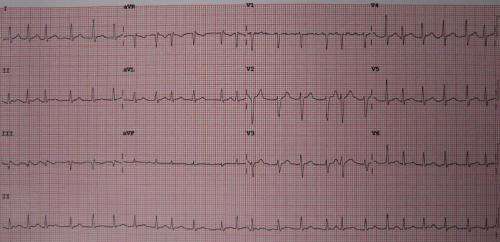GPs rank screening for heart rhythm disorder nearly as important as for common cancers

Screening for atrial fibrillation should be integrated into flu vaccination and cancer screening programs, according to a survey of GPs conducted by the AFFECT-EU project and presented at EHRA 2022, a scientific congress of the European Society of Cardiology (ESC).
"Our study indicates that few atrial fibrillation screening programs are established in Europe, yet GPs strongly believe they are needed," said study author Ms. Paulien Vermunicht, a doctoral student at the University of Antwerp, Belgium.
Atrial fibrillation is the most common heart rhythm disorder, affecting more than 40 million individuals globally. People with the condition have a five times greater risk of stroke than their healthy peers. Atrial fibrillation often has no symptoms and remains undiagnosed, leaving patients unprotected from stroke.
AFFECT-EU is a large-scale EU funded project to define the optimal screening strategy for atrial fibrillation with the ultimate aim of preventing subsequent strokes and premature death. The project previously reported that opportunistic screening in primary care with single lead electrocardiogram (ECG) devices was considered the most feasible approach by healthcare professionals and regulators.
Screening in this way is performed when a patient attends the practice for any reason. The patient's heart rhythm is assessed using a single lead ECG which is generally a compact, handheld device that is quick and simple to use. GPs in Europe were asked their opinions of implementing this screening approach in daily clinical practice and the results are presented today.
A multiple choice survey was emailed to GP contacts of AFFECT-EU consortium members and GP organizations. There were four sections: 1) general characteristics of the participants (e.g. location); 2) current practice and perceptions of screening for different diseases; 3) feasibility of opportunistic single lead ECG screening; 4) barriers to implementing this type of screening and preferred solutions.
A total of 561 responses were collected (37.1% Eastern, 29.4% Central, 12.1% Southern, 11.1% Northern, 9.4% Western Europe and 0.9% outside Europe). Regarding current practice, 87% of GPs indicated that no atrial fibrillation screening is established in their region, while 70.1%, 80.9% and 87.3% said programs were in place for colon, breast and cervical cancers, respectively. However, the need for standardized atrial fibrillation screening was rated as 82.3 on a scale from 0 to 100, which was almost as high as for colon (86.5), breast (86.8) and cervical (89.2) cancers.
As for feasibility, just 12.8% of GPs had a single lead ECG device in their practice. Nevertheless, three in five (60.4%) said they would feel confident in ruling out atrial fibrillation on a 30-second single lead ECG rhythm strip.
One in four (25.3%) GPs reported no obstacles to starting atrial fibrillation screening. However, nearly one in five (18.9%) said they needed more education before commencing. Almost one in five (18.7%) stated that there were insufficient resources to implement a program in their practice including personnel and an ECG qualification. Just over one in ten (10.5%) were concerned about detecting false positives (i.e. erroneously diagnosing atrial fibrillation) that could lead to anxiety or harm for the patient.
One of the main solutions, selected by 24.3% of GPs, was to integrate atrial fibrillation screening into existing flu vaccination or cancer screening programs. The second most popular idea, selected by 24.2% of respondents, was to incorporate an algorithm into primary care software systems to identify patients suitable for atrial fibrillation screening based on their age and/or medical history.
Project coordinator Professor Renate Schnabel of the University Medical Centre Hamburg-Eppendorf, Germany says that "the AFFECT-EU consortium has created an algorithm that identifies patients at risk of atrial fibrillation based on the information in their medical record. When the patient visits the practice for any reason, the primary care software system alerts GPs who can then perform ECG screening. This procedure is being tested in Germany and is a big step forward."
During a session dedicated to EHRA's EU-funded research projects, Professor Schnabel will discuss the latest information from AFFECT-EU on the cost benefits and acceptability of atrial fibrillation screening across Europe.
More information: Conference: digital-congress.escardio.org/ … n-risk-factors-in-af
D Engler et al, Atrial fibrillation screening: feasible approaches and implementation challenges across Europe, European Heart Journal (2021). DOI: 10.1093/eurheartj/ehab724.3132
Gerhard Hindricks et al, Corrigendum to: 2020 ESC Guidelines for the diagnosis and management of atrial fibrillation developed in collaboration with the European Association for Cardio-Thoracic Surgery (EACTS): The Task Force for the diagnosis and management of atrial fibrillation of the European Society of Cardiology (ESC) Developed with the special contribution of the European Heart Rhythm Association (EHRA) of the ESC, European Heart Journal (2021). DOI: 10.1093/eurheartj/ehab648



















